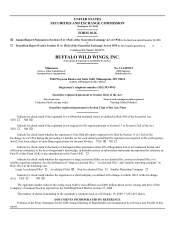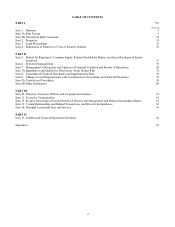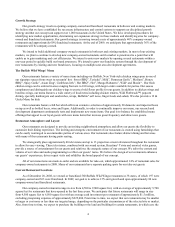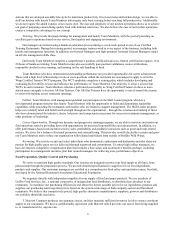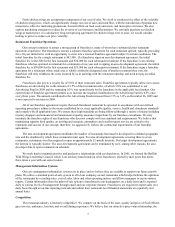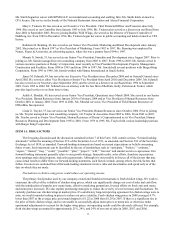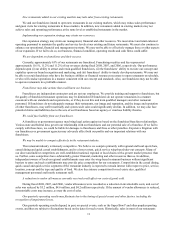Buffalo Wild Wings 2008 Annual Report Download - page 11
Download and view the complete annual report
Please find page 11 of the 2008 Buffalo Wild Wings annual report below. You can navigate through the pages in the report by either clicking on the pages listed below, or by using the keyword search tool below to find specific information within the annual report. 11
New restaurants added to our existing markets may take sales from existing restaurants.
We and our franchisees intend to open new restaurants in our existing markets, which may reduce sales performance
and guest visits for existing restaurants in those markets. In addition, new restaurants added in existing markets may not
achieve sales and operating performance at the same level as established restaurants in the market.
Implementing our expansion strategy may strain our resources.
Our expansion strategy may strain our management, financial and other resources. We must attract and retain talented
operating personnel to maintain the quality and service levels at our existing and future restaurants. We must also continue to
enhance our operational, financial and management systems. We may not be able to effectively manage these or other aspects
of our expansion. If we fail to do so, our business, financial condition, operating results and cash flows could suffer.
We are dependent on franchisees and their success.
Currently, approximately 65% of our restaurants are franchised. Franchising royalties and fees represented
approximately 10.1%, 11.2% and 11.2% of our revenues during fiscal 2008, 2007, and 2006, respectively. Our performance
depends upon (i) our ability to attract and retain qualified franchisees, (ii) the franchisees’ ability to execute our concept and
capitalize upon our brand recognition and marketing, and (iii) franchisees’ ability to timely develop restaurants. We may not
be able to recruit franchisees who have the business abilities or financial resources necessary to open restaurants on schedule,
or who will conduct operations in a manner consistent with our concept and standards. Also, our franchisees may not be able
to operate restaurants in a profitable manner.
Franchisees may take actions that could harm our business.
Franchisees are independent contractors and are not our employees. We provide training and support to franchisees, but
the quality of franchised restaurant operations may be diminished if franchisees do not operate restaurants in a manner
consistent with our standards and requirements, or if they do not hire and train qualified managers and other restaurant
personnel. If franchisees do not adequately manage their restaurants, our image and reputation, and the image and reputation
of other franchisees, may suffer materially and system-wide sales could significantly decline. In addition, we may also face
potential claims and liabilities due to the acts of our franchisees based on agency or vicarious liability theories.
We could face liability from our franchisees.
A franchisee or government agency may bring legal action against us based on the franchisee/franchisor relationships.
Various state and federal laws govern our relationship with our franchisees and our potential sale of a franchise. If we fail to
comply with these laws, we could be liable for damages to franchisees and fines or other penalties. Expensive litigation with
our franchisees or government agencies may adversely affect both our profits and our important relations with our
franchisees.
We may be unable to compete effectively in the restaurant industry.
The restaurant industry is intensely competitive. We believe we compete primarily with regional and local sports bars,
casual dining and quick casual establishments, and to a lesser extent, quick service wing-based take-out concepts. Many of
our direct and indirect competitors are well-established national, regional or local chains with a greater market presence than
us. Further, some competitors have substantially greater financial, marketing and other resources than us. In addition,
independent owners of local or regional establishments may enter the wing-based restaurant business without significant
barriers to entry and such establishments may provide price competition for our restaurants. Competition in the casual dining,
quick casual and quick service segments of the restaurant industry is expected to remain intense with respect to price, service,
location, concept and the type and quality of food. We also face intense competition for real estate sites, qualified
management personnel and hourly restaurant staff.
A reduction in vendor allowances currently received could affect our costs of goods sold.
During fiscal 2008, 2007, and 2006, vendor allowances were recorded as a reduction in inventoriable costs, and cost of
sales was reduced by $5.2 million, $4.6 million, and $4.2 million respectively. If the amount of vendor allowances is reduced,
inventoriable costs may increase, as may the cost of sales.
Our quarterly operating results may fluctuate due to the timing of special events and other factors, including the
recognition of impairment losses.
Our quarterly operating results depend, in part, on special events, such as the Super Bowl® and other popular sporting
events, and thus are subject to fluctuations based on the dates for such events. Historically, sales in most of our restaurants

